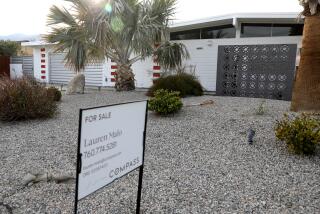CBRE Group builds for the future
With corporate headquarters overlooking the hot office market in West Los Angeles, CBRE Group Inc. — the world’s largest real estate services firm — finished 2012 with a record $6.5 billion in revenue, and its new boss is optimistic about the year ahead.
“We think the economy is going to grow a couple of points this year, and we are expecting our business to grow considerably,” said Robert Sulentic, 56, who took over as chief executive in December from Brett White, who retired. Earlier, Sulentic was chief executive of Texas real estate company Trammell Crow Co., which was acquired by CBRE in 2006.
The December changing of the guard at CBRE came as the company’s commercial real estate sales and leases are on the upswing in the much of the world. They represent a big change from recession-era days when Sulentic was chief financial officer and the company reported two quarters in the red.
The company can trace its roots back more than 100 years and was known for decades as Coldwell Banker & Co.
Although it maintains a modest profile in its longtime hometown of Los Angeles, CBRE has a vast footprint, with offices in 60 countries, including major outposts in such commercial centers as London, Paris, Sydney, Hong Kong and Singapore. In all, it has 37,000 employees.
In 2012, the company reported almost $316 million in net earnings, an increase of 32% over the year before. Brokers’ commissions for arranging sales of a growing number of office buildings, warehouses, shopping centers and hotels accounted for a large chunk of that income. The company’s stock closed at $23.93 a share Wednesday, near a 52-week high.
The upswing in the global economy lifted the company, an analyst said, but stability may still be elusive.
“If a conflict in Cyprus gets everyone bent out of shape, just think how bad it would be if a big country had a serious setback,” said Craig Silvers, president of Bricks & Mortar Capital.
In a wide-ranging interview, Sulentic, who grew up in Iowa and graduated from Harvard Business School, recently discussed the state of the real estate market and the direction he intends to take his Fortune 500 firm.
Last year ended on a high note financially for your company. Do you think times will stay good enough to support more growth?
We think the economy is going to grow a couple of points this year, and we are expecting our business to grow considerably. We are not euphoric, but we are quite positive on the prospects for the year. Earnings were generally good for American corporations last year. Companies are growing slowly, but growing.
What kinds of companies will see the most growth?
Tech, energy and manufacturing. The U.S. has become more competitive at manufacturing as Asia gets more costly. We are not seeing growth in the finance industry right now, though.
Sometimes our leaders in Washington seem determined to mess up this growth spurt with their bickering. Could they?
I think we will fix our problems with the sequester. What we don’t have this year is an election, and that’s a good thing. Europe is a lot more complex. Europe is still a massive, mature economy, and if that thing doesn’t work appropriately then it’s going to be a drag on the rest of the world.
Commercial real estate typically costs millions of dollars. Who is buying it?
Among the buyers are institutions, families, sovereign wealth funds. I was in London two months ago — the money is chasing such “world” cities because they are considered stable. The yields are good relative to what you can get in other investment classes and you can sell when you want to get out.
That’s good news for London, L.A. and other popular international business destinations, but what about smaller cities?
We think you are going to see buying spread. There are now very strong secondary markets like Dallas and Seattle — cities that are large world cities but not New York; Los Angeles; Washington, D.C.; and San Francisco.
Prices for some trophy buildings in top markets are surpassing pre-recession peaks. Are investors already in danger of going too far?
I don’t think we are faced with a bubble here. It’s hard to get a bubble with 2% growth.
The office market doesn’t seem to be picking up much for landlords, though.
We are seeing a slow improvement, with rents heading up. It’s not a precipitous jump, but it’s a nice move and not a lot of new office product is coming online.
What about the shift in many companies toward “open plan” workplaces without individual offices and the rise of telecommuting?
One reason office occupancy is not growing more rapidly is that the alternative workplace, a paperless and wireless environment, is finally getting legs. We have a new generation of workers who grew up aspiring to that kind of workplace, and we are adapting. You should be able to use less square footage if you’re careful about it.
CBRE Group laid off workers during the economic downturn and spent two quarters in the red. Has your company’s return to financial health resulted in more jobs?
We have done substantial hiring and grown considerably, partly through acquisitions and winning new accounts. In the down economy of 2009, we had 29,000 employees. Now we have 37,000, a new high. We’re focused on growth in all regions around the world.







